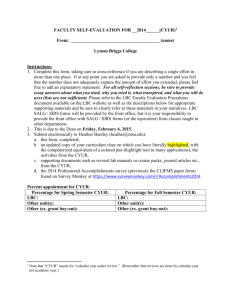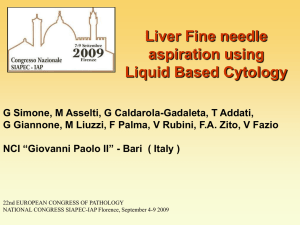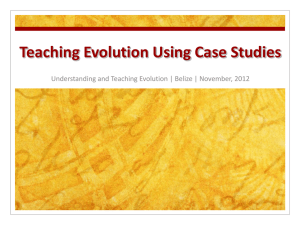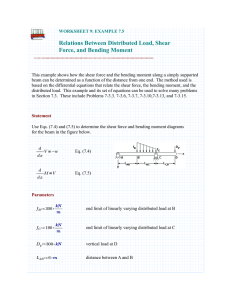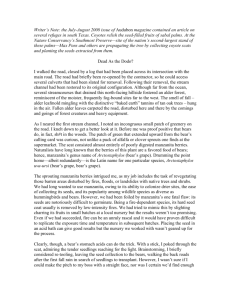Homework 13
advertisement
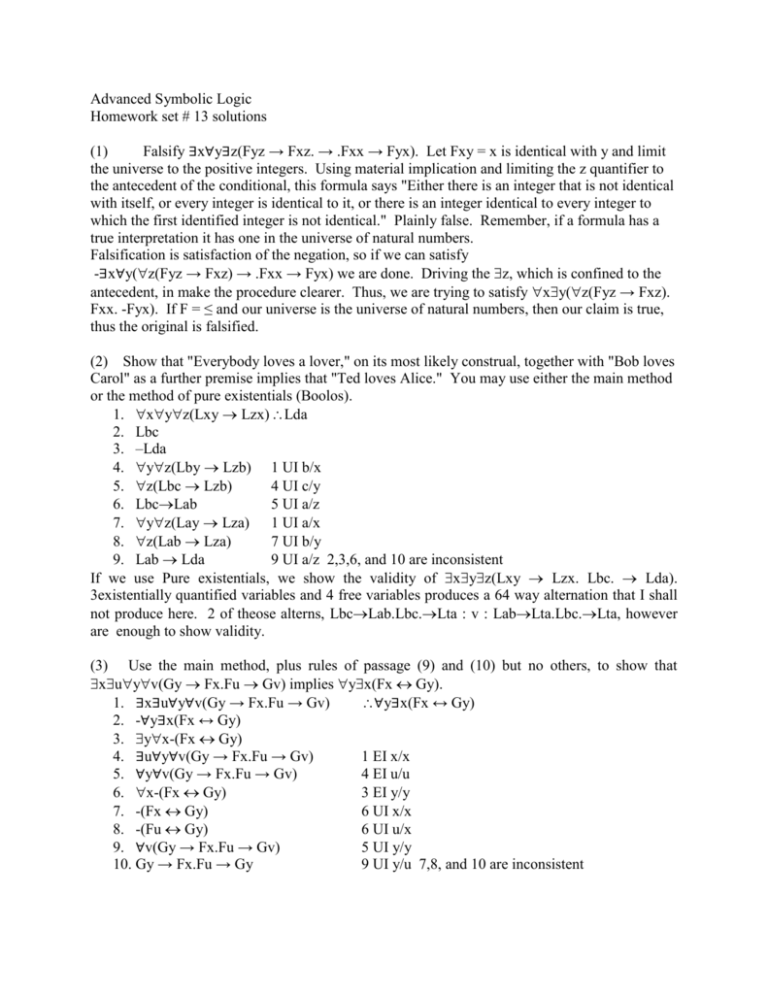
Advanced Symbolic Logic Homework set # 13 solutions (1) Falsify ∃x∀y∃z(Fyz → Fxz. → .Fxx → Fyx). Let Fxy = x is identical with y and limit the universe to the positive integers. Using material implication and limiting the z quantifier to the antecedent of the conditional, this formula says "Either there is an integer that is not identical with itself, or every integer is identical to it, or there is an integer identical to every integer to which the first identified integer is not identical." Plainly false. Remember, if a formula has a true interpretation it has one in the universe of natural numbers. Falsification is satisfaction of the negation, so if we can satisfy -∃x∀y(z(Fyz → Fxz) → .Fxx → Fyx) we are done. Driving the z, which is confined to the antecedent, in make the procedure clearer. Thus, we are trying to satisfy xy(z(Fyz → Fxz). Fxx. -Fyx). If F = ≤ and our universe is the universe of natural numbers, then our claim is true, thus the original is falsified. (2) Show that "Everybody loves a lover," on its most likely construal, together with "Bob loves Carol" as a further premise implies that "Ted loves Alice." You may use either the main method or the method of pure existentials (Boolos). 1. xyz(Lxy Lzx) Lda 2. Lbc 3. –Lda 4. yz(Lby Lzb) 1 UI b/x 5. z(Lbc Lzb) 4 UI c/y 6. LbcLab 5 UI a/z 7. yz(Lay Lza) 1 UI a/x 8. z(Lab Lza) 7 UI b/y 9. Lab Lda 9 UI a/z 2,3,6, and 10 are inconsistent If we use Pure existentials, we show the validity of xyz(Lxy Lzx. Lbc. Lda). 3existentially quantified variables and 4 free variables produces a 64 way alternation that I shall not produce here. 2 of theose alterns, LbcLab.Lbc.Lta : v : LabLta.Lbc.Lta, however are enough to show validity. (3) Use the main method, plus rules of passage (9) and (10) but no others, to show that xuyv(Gy Fx.Fu Gv) implies yx(Fx Gy). 1. ∃x∃u∀y∀v(Gy → Fx.Fu → Gv) ∀y∃x(Fx ↔ Gy) 2. -∀y∃x(Fx ↔ Gy) 3. yx-(Fx Gy) 4. ∃u∀y∀v(Gy → Fx.Fu → Gv) 1 EI x/x 5. ∀y∀v(Gy → Fx.Fu → Gv) 4 EI u/u 6. x-(Fx Gy) 3 EI y/y 7. -(Fx Gy) 6 UI x/x 8. -(Fu Gy) 6 UI u/x 9. ∀v(Gy → Fx.Fu → Gv) 5 UI y/y 10. Gy → Fx.Fu → Gy 9 UI y/u 7,8, and 10 are inconsistent (4) Show that "Everybody loves my baby but my baby loves nobody but me" implies "I am my baby." To simplify things a little, you may symbolize the conclusion as if it read "My baby is me." (Cartwright) 1. xLxb 2. x(Lbx x =m) m=b 3. m b neg of conclusion 4. Lbb 1 UI b/x 5. Lbb b = m 2 UI b/x 6. b = b Axiom II 7. b = b. b =m. m = b Axiom I 3-7 are inconsistent (5) Use the main method, plus the axioms of identity, to show that xFx and y-Fy imply xy(x≠y). 1. xFx ∀x∃y(x≠y) 2. y-Fy 3. -∀x∃y(x≠y) 4. xy(x=y) 5. Fx 1 EI x/x 6. –Fy 2 EI y/y 7. y(z = y) 4 EI z/x 8. z = x 7 UI x/y 9. y=x 7 UI y/y 10. Fz. z = y. Fy Axiom I 11. –Fz. z=x. -Fx Axiom I 5,6,8.9.10, and 11 are inconsistent (6) Show that "There is a dodo who admires every dodo," "Dodos all admire whatever admire them," and "A dodo who admires any dodo admires every dodo," imply "Each dodo admires every dodo." (Koopman) 1. xy(Dx.Dy Axy) 2. xy(Dx . Ayx Axy) 3. xyz(Dx.Dy.Axy..DzAxz) 4. xy(Dx.Dy.-Axy) negation of conclusion 5. y(Ds.Dy.-Asy) 4, EI s/x 6. Ds.Dt.-Ast 5, EI t/y 7. y(Dw.Dy Awy) 1, EI w/x 8. Dw.Ds Aws 7, UI s/y 9. y(Ds . Ays Asy) 2, UI s/x 10. Ds . Aws Asw 9, UI w/y 11. yz(Ds.Dy.Asy..DzAsz) 3, UI s/t 12. z(Ds.Dw.Asw..DzAsz) 11, UI w/y 13. Ds.Dw.Asw..DtAst 12, UI t/z 6,8,10 &13 are inconsistent

